2010 HONDA CR-V seats
[x] Cancel search: seatsPage 56 of 441
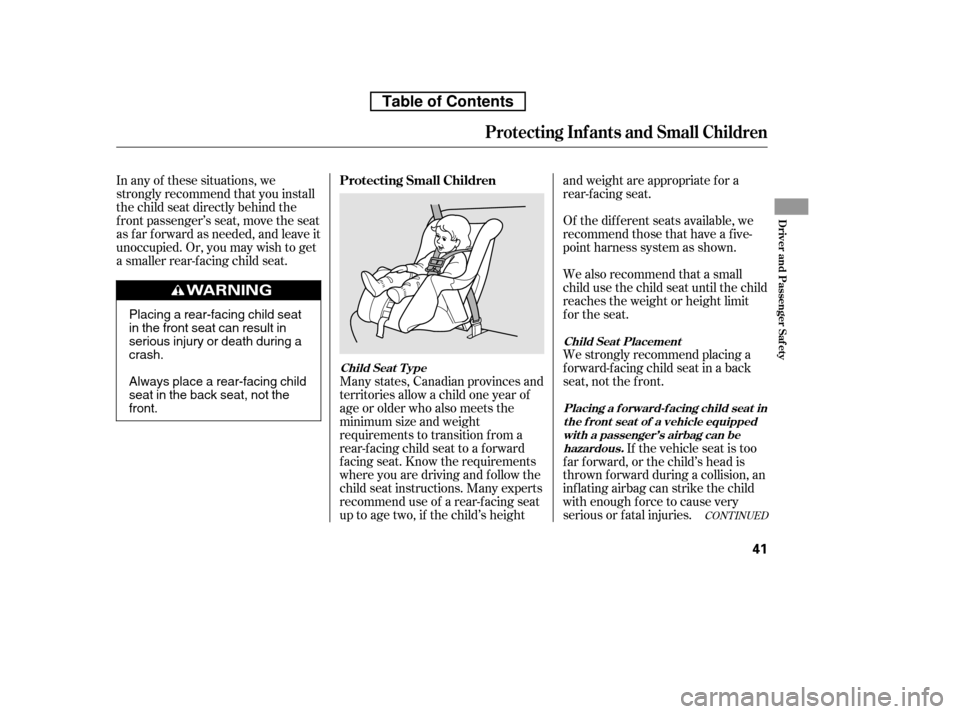
In any of these situations, we
strongly recommend that you install
the child seat directly behind the
f ront passenger’s seat, move the seat
as far forward as needed, and leave it
unoccupied. Or, you may wish to get
a smaller rear-f acing child seat.Many states, Canadian provinces and
territories allow a child one year of
age or older who also meets the
minimum size and weight
requirements to transition f rom a
rear-facing child seat to a forward
f acing seat. Know the requirements
where you are driving and follow the
child seat instructions. Many experts
recommend use of a rear-f acing seat
up to age two, if the child’s heightand weight are appropriate f or a
rear-f acing seat.
If the vehicle seat is too
f ar f orward, or the child’s head is
thrown f orward during a collision, an
inf lating airbag can strike the child
with enough force to cause very
serious or f atal injuries.
We strongly recommend placing a
forward-facing child seat in a back
seat, not the f ront.
We also recommend that a small
child use the child seat until the child
reaches the weight or height limit
for the seat.
Of the different seats available, we
recommend those that have a f ive-
point harness system as shown.
CONT INUED
Protecting Small Children
Child Seat T ype
Placing a f orward-f acing child seat int he f ront seat of a vehicle equipped
with a passenger’s airbag can behazardous.
Child Seat Placement
Protecting Inf ants and Small Children
Driver and Passenger Saf ety
41
Placing a rear-facing child seat
in the front seat can result in
serious injury or death during acrash.
Always place a rear-facing child
seat in the back seat, not thefront.
Table of Contents
Page 57 of 441
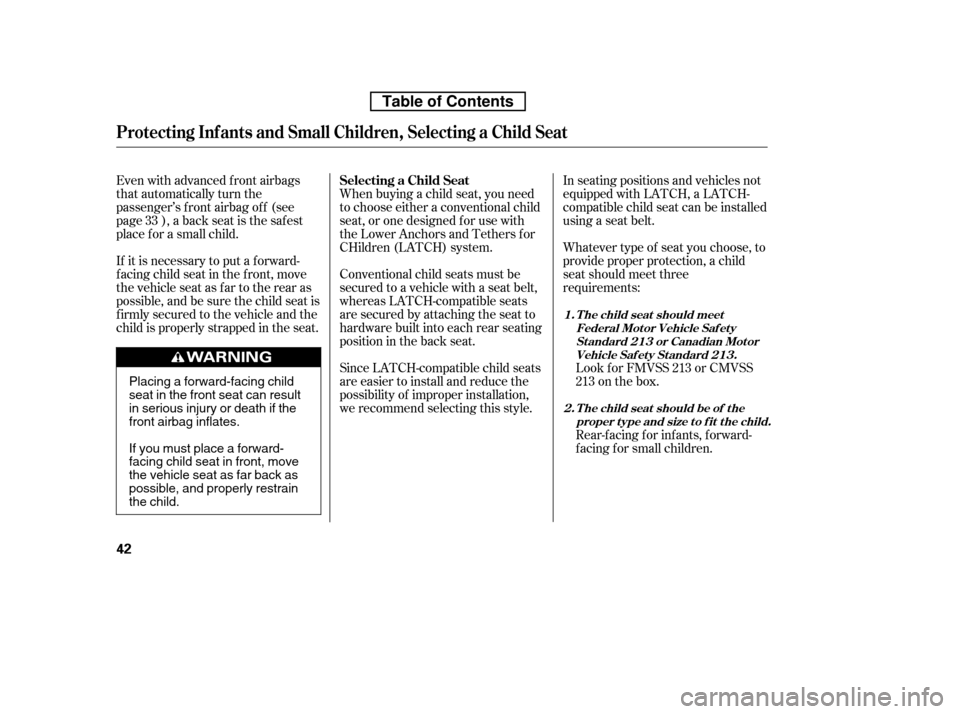
In seating positions and vehicles not
equipped with LATCH, a LATCH-
compatible child seat can be installed
using a seat belt.
Whatever type of seat you choose, to
provide proper protection, a child
seat should meet three
requirements:Look f or FMVSS 213 or CMVSS
213 on the box.
Since LATCH-compatible child seats
are easier to install and reduce the
possibility of improper installation,
we recommend selecting this style.
When buying a child seat, you need
to choose either a conventional child
seat, or one designed f or use with
the Lower Anchors and Tethers f or
CHildren (LATCH) system.
If it is necessary to put a f orward-
f acing child seat in the f ront, move
the vehicle seat as far to the rear as
possible, and be sure the child seat is
f irmly secured to the vehicle and the
child is properly strapped in the seat.
Even with advanced front airbags
that automatically turn the
passenger’s f ront airbag of f (see
page ), a back seat is the saf est
place f or a small child.
Conventional child seats must be
secured to a vehicle with a seat belt,
whereas LATCH-compatible seats
are secured by attaching the seat to
hardware built into each rear seating
position in the back seat.
Rear-facing for infants, forward-
f acing f or small children.
33
T he child seat should meet
Federal Mot or Vehicle Saf et ySt andard 213 or Canadian Mot or
Vehicle Saf et y St andard 213.
T he child seat should be of theproper t ype and size t o f it t he child.
1.
2.
Selecting a Child Seat
Protecting Inf ants and Small Children, Selecting a Child Seat
42
Placing a forward-facing child
seat in the front seat can result
in serious injury or death if the
front airbag inflates.
Ifyoumustplaceaforward-
facing child seat in front, move
the vehicle seat as far back as
possible, and properly restrain
the child.
Table of Contents
Page 58 of 441
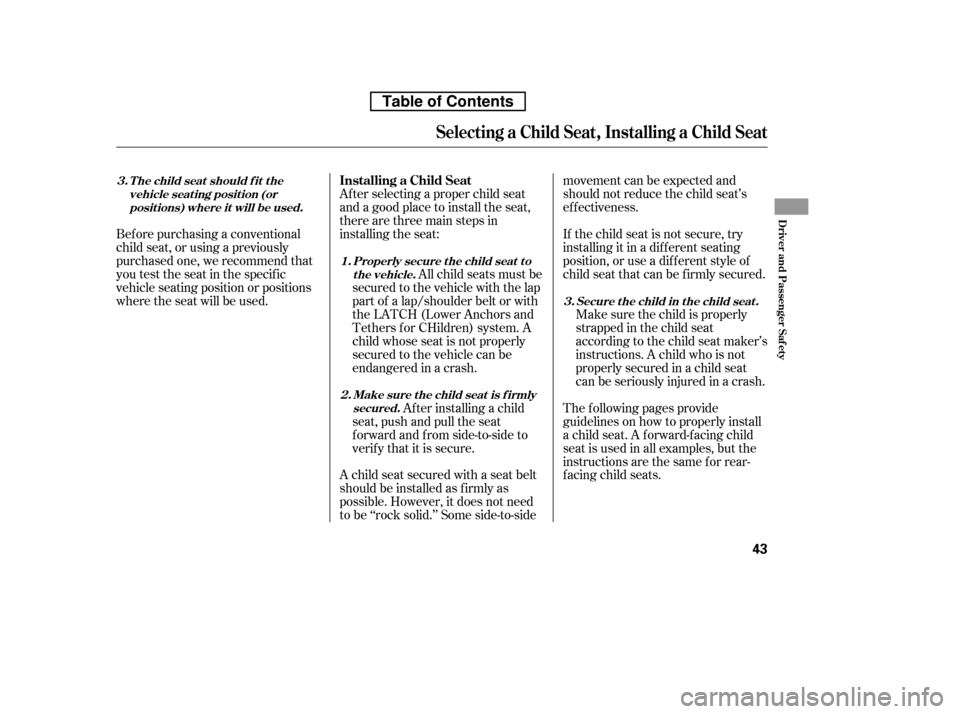
Af ter selecting a proper child seat
and a good place to install the seat,
there are three main steps in
installing the seat:Af ter installing a child
seat, push and pull the seat
f orward and f rom side-to-side to
verif y that it is secure.
A child seat secured with a seat belt
should be installed as f irmly as
possible. However, it does not need
to be ‘‘rock solid.’’ Some side-to-side movement can be expected and
should not reduce the child seat’s
ef f ectiveness.
If the child seat is not secure, try
installing it in a dif f erent seating
position, or use a dif f erent style of
child seat that can be f irmly secured.
Make sure the child is properly
strappedinthechildseat
according to the child seat maker’s
instructions. A child who is not
properly secured in a child seat
can be seriously injured in a crash.
The f ollowing pages provide
guidelines on how to properly install
a child seat. A f orward-f acing child
seat is used in all examples, but the
instructions are the same f or rear-
f acing child seats.
All child seats must be
secured to the vehicle with the lap
part of a lap/shoulder belt or with
the LATCH (Lower Anchors and
Tethers f or CHildren) system. A
child whose seat is not properly
secured to the vehicle can be
endangered in a crash.
Bef ore purchasing a conventional
child seat, or using a previously
purchased one, we recommend that
you test the seat in the specif ic
vehicle seating position or positions
where the seat will be used.
Installing a Child Seat
Make sure t he child seat is f irmly
secured. Secure the child in the child seat.
Properly secure t he child seat t o
the vehicle.
T he child seat should f it the
vehicle seat ing posit ion (orposit ions) where it will be used.
3.
1.
2. 3.
Selecting a Child Seat, Installing a Child Seat
Driver and Passenger Saf ety
43
Table of Contents
Page 59 of 441
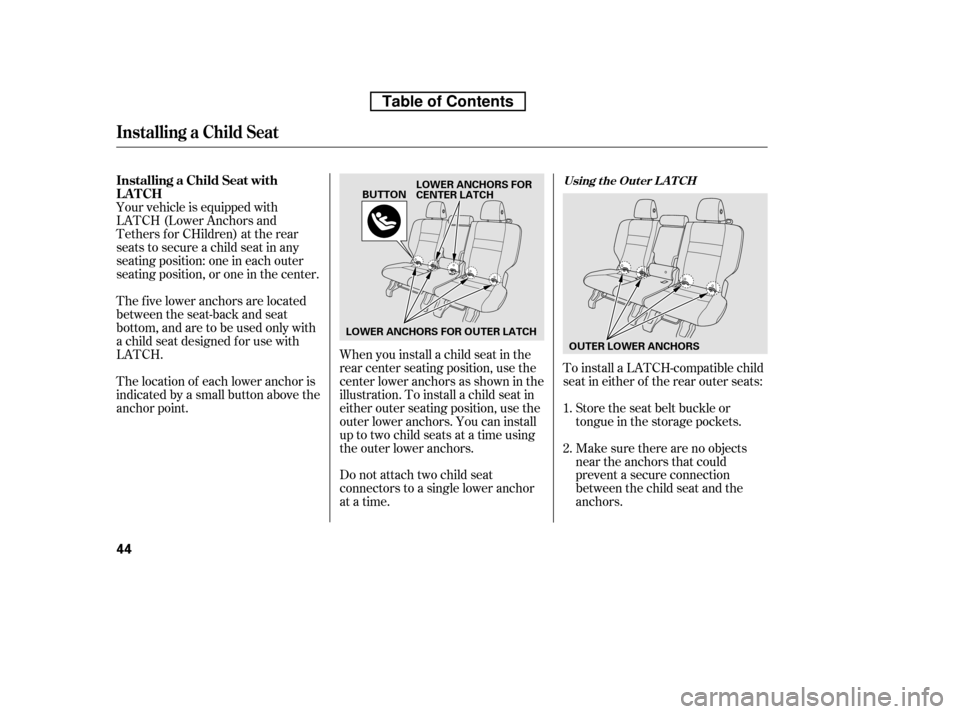
Your vehicle is equipped with
LATCH (Lower Anchors and
Tethers f or CHildren) at the rear
seats to secure a child seat in any
seating position: one in each outer
seating position, or one in the center.
Thefiveloweranchorsarelocated
between the seat-back and seat
bottom, and are to be used only with
a child seat designed f or use with
LATCH.
The location of each lower anchor is
indicated by a small button above the
anchor point.When you install a child seat in the
rear center seating position, use the
center lower anchors as shown in the
illustration. To install a child seat in
either outer seating position, use the
outer lower anchors. You can install
up to two child seats at a time using
the outer lower anchors.
Do not attach two child seat
connectors to a single lower anchor
at a time. Make sure there are no objects
near the anchors that could
prevent a secure connection
between the child seat and the
anchors.
Store the seat belt buckle or
tongue in the storage pockets.
To install a LATCH-compatible child
seat in either of the rear outer seats: 1. 2.
Installing a Child Seat with
LATCH
Using t he Out er L A T CH
Installing a Child Seat
44
LOWER ANCHORS FOR OUTER LATCH
BUTTON
LOWER ANCHORS FOR
CENTER LATCH
OUTER LOWER ANCHORS
Table of Contents
Page 60 of 441
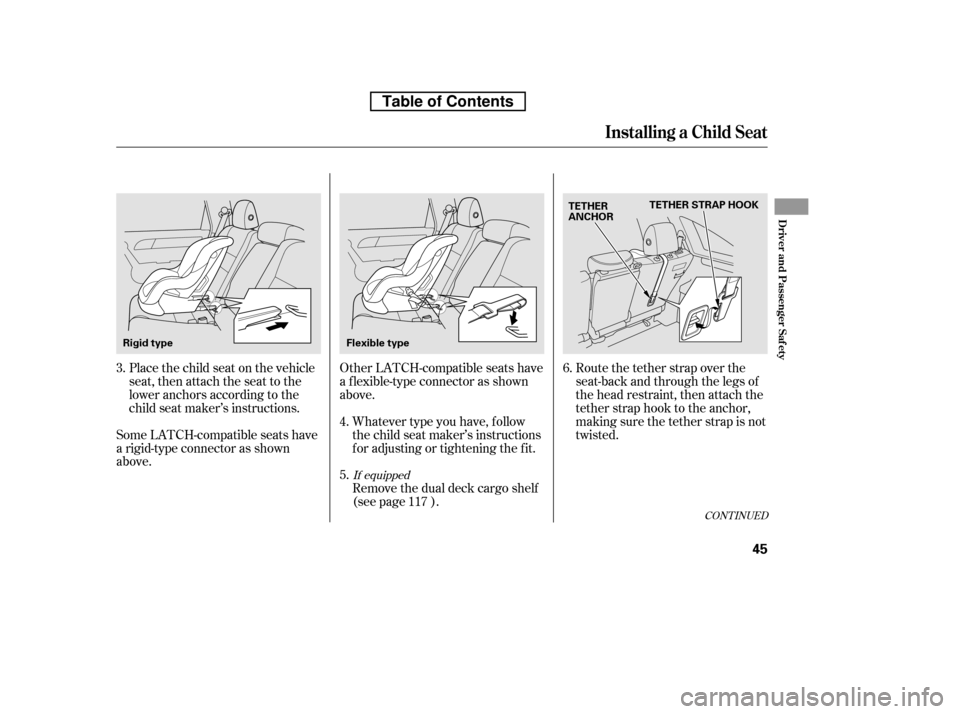
Place the child seat on the vehicle
seat, then attach the seat to the
lower anchors according to the
child seat maker’s instructions.
Some LATCH-compatible seats have
a rigid-type connector as shown
above. Whatever type you have, f ollow
the child seat maker’s instructions
f or adjusting or tightening the f it.
Remove the dual deck cargo shelf
(see page ).
Other LATCH-compatible seats have
a f lexible-type connector as shown
above.
Route the tether strap over the
seat-back and through the legs of
the head restraint, then attach the
tether strap hook to the anchor,
making sure the tether strap is not
twisted.
5.
4.
3.
6.
117
CONT INUED
If equipped
Installing a Child Seat
Driver and Passenger Saf ety
45
Flexible type
Rigid type TETHER
ANCHOR
TETHER STRAP HOOK
Table of Contents
Page 62 of 441
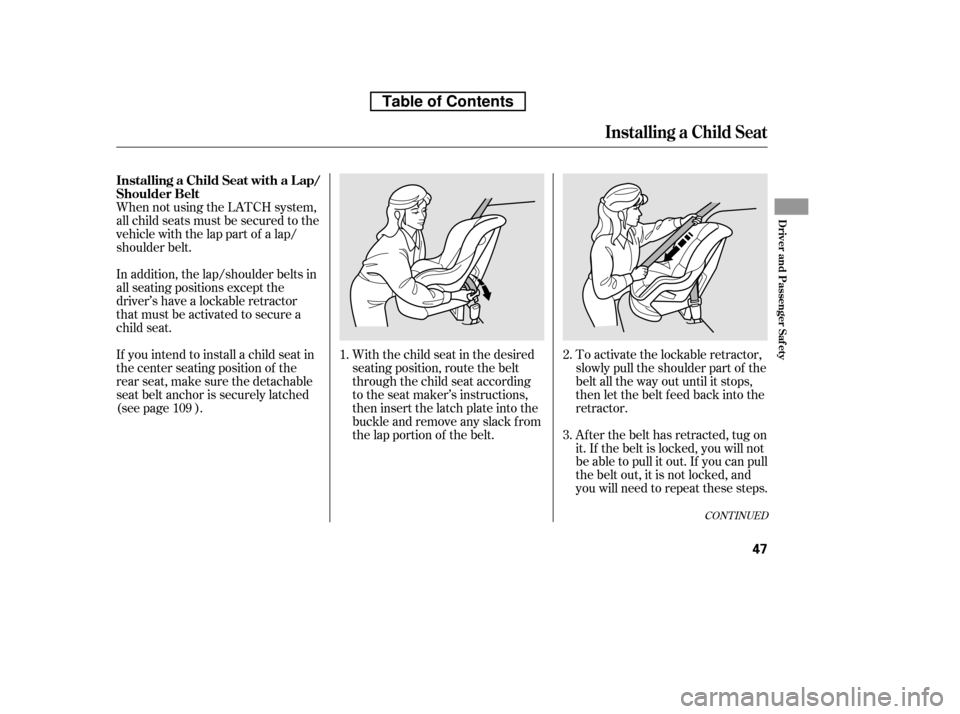
When not using the LATCH system,
all child seats must be secured to the
vehicle with the lap part of a lap/
shoulder belt.With the child seat in the desired
seating position, route the belt
through the child seat according
to the seat maker’s instructions,
then insert the latch plate into the
buckle and remove any slack f rom
the lap portion of the belt.To activate the lockable retractor,
slowly pull the shoulder part of the
belt all the way out until it stops,
then let the belt f eed back into the
retractor.
Af ter the belt has retracted, tug on
it. If the belt is locked, you will not
be able to pull it out. If you can pull
thebeltout,itisnotlocked,and
you will need to repeat these steps.
In addition, the lap/shoulder belts in
all seating positions except the
driver’s have a lockable retractor
that must be activated to secure a
child seat.
If you intend to install a child seat in
the center seating position of the
rear seat, make sure the detachable
seat belt anchor is securely latched
(see page ).
2.
1.
3.
109
CONT INUED
Installing a Child Seat with a L ap/
Shoulder Belt
Installing a Child Seat
Driver and Passenger Saf ety
47
Table of Contents
Page 67 of 441
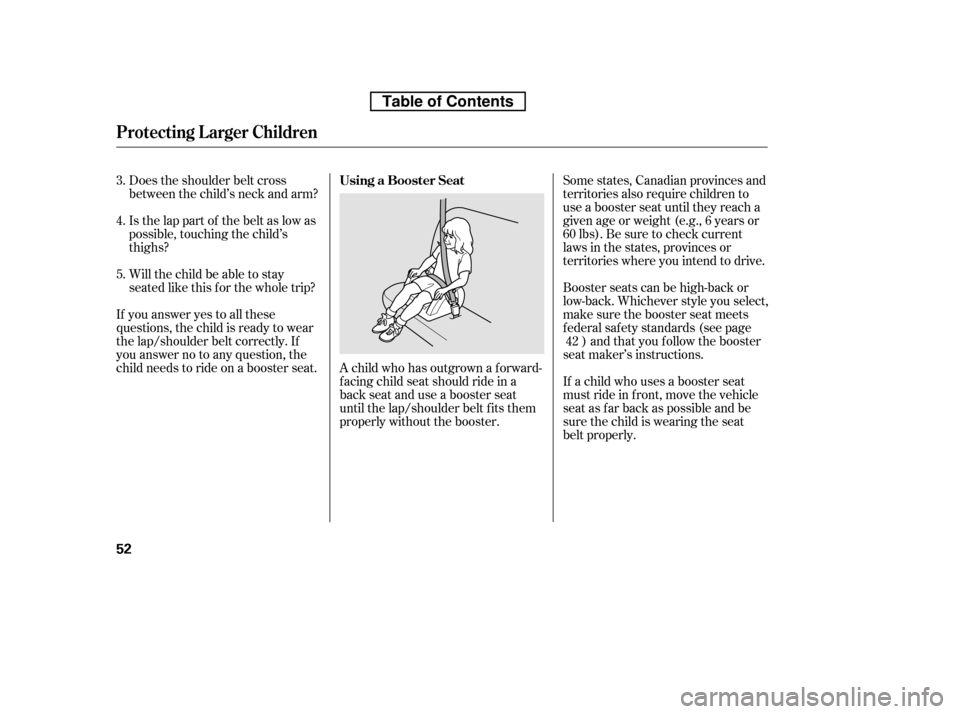
Does the shoulder belt cross
between the child’s neck and arm?
Is the lap part of the belt as low as
possible, touching the child’s
thighs?
Will the child be able to stay
seated like this f or the whole trip?
If you answer yes to all these
questions, the child is ready to wear
the lap/shoulder belt correctly. If
you answer no to any question, the
child needs to ride on a booster seat. A child who has outgrown a f orward- f acing child seat should ride in a
back seat and use a booster seat
until the lap/shoulder belt f its them
properly without the booster.Booster seats can be high-back or
low-back. Whichever style you select,
make sure the booster seat meets
f ederal saf ety standards (see page
) and that you f ollow the booster
seat maker’s instructions.
If a child who uses a booster seat
must ride in f ront, move the vehicle
seat as far back as possible and be
sure the child is wearing the seat
belt properly.
Some states, Canadian provinces and
territories also require children to
use a booster seat until they reach a
given age or weight (e.g., 6 years or
60lbs).Besuretocheckcurrent
laws in the states, provinces or
territories where you intend to drive.
3. 4. 5.
42
Using a Booster Seat
Protecting L arger Children
52
Table of Contents
Page 74 of 441

This section gives inf ormation about
the controls and displays that
contribute to the daily operation of
your vehicle. All the essential
controls are within easy reach............................
Control Locations . 60............................
Instrument Panel . 61 ..........
Instrument Panel Indicators . 62
.............................................
Gauges . 68
....................
Inf ormation Display . 69
...................................
Trip Meter . 69
................
Instant Fuel Economy . 70
..............
Average Fuel Economy . 70
...........................................
Range . 70
.....................................
Odometer . 71
..................................
Fuel Gauge . 71
...................
Temperature Gauge . 71
Outside Temperature
..................................
Indicator . 71
..........
Check Fuel Cap Message . 73
..................
Maintenance Minder . 73
Controls Near the Steering
...........................................
Wheel . 74
.
Windshield Wipers and Washers . 75
.........
Turn Signals and Headlights . 76
........
Instrument Panel Brightness . 79
.................
Hazard Warning Button . 79
.................
Rear Window Def ogger . 80
.................................
Parking Brake . 81
..........
Steering Wheel Adjustment . 81
...............................
Keys and Locks . 82
........................
Immobilizer System . 83
................................
Ignition Switch . 84 ......................................
Door Locks . 85
......................
Power Door Locks . 85
.
Auto Door Locking/Unlocking . 86
..............
Childproof Door Locks . 91
.......................
Remote Transmitter . 92
............................................
Tailgate . 95
.................................................
Seats . 97
..................................
Seat Heaters . 111
............................
Power Windows . 112
.......................................
Moonroof . 113
...........................................
Mirrors . 114
.........
Interior Convenience Items . 116
............
Dual Deck Cargo Shelf . 117
.....................
Beverage Holders . 119
.............................
Center Table . 120
......................
Lower Glove Box . 120
......................
Upper Glove Box . 121
............................
Vanity Mirror . 121
...................................
Sun Visor . 122
....................
Sunglasses Holder . 122
................
Conversation Mirror . 123
........
Accessory Power Sockets . 123
.............
Console Compartment . 124
..................................
Coat Hook . 125
.......................
Seat Under Tray . 125
...............................
Interior Lights . 126
Instruments and Controls
Inst rument s and Cont rols
59